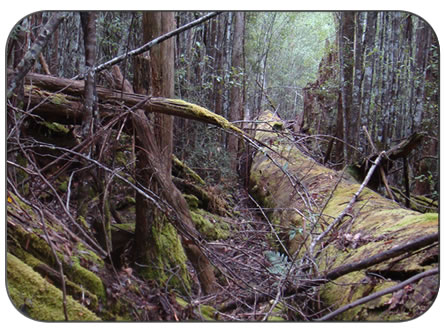 Bindi Browning,
Bindi Browning,
School of Plant Science, UTAS
What Grows on Dead Logs?
Have you ever been to a forest and admired all those amazing big trees? The towering giants that make you fall over backwards just to see the top?
Well I say: What about the little guys?! Bryophytes are amazing little moss and liverwort plants that grow on just about everything in forests. They are the often overlooked but incredibly important and diverse part of forest ecosystems. Plus – they’re so pretty! They can be seen growing in big thick green carpets on the ground and on logs, as well as on trees and rocks.
I have always been fascinated by nature. My family lived out in the bush and I would always be outside somewhere collecting bits of trees and bugs and spent my time trying to identify the things I collected. I became passionate about the environment, particularly forests and wanted to do something to help manage them better.
I remember in Year 10 being asked to imagine what I would be doing in 5 and 10 years time. I stumbled across the term “environmental scientist” and it was then I decided what I really wanted to do. I was going to make a difference out there in the world of forest management by becoming an environmental scientist.
At university I studied environmental management, zoology and botany and one of my favourite courses was field botany. It was on a week long excursion that I discovered bryophytes and I was amazed by the diversity of these little plants even in one small patch of forest. It also helped that one of our teachers was very enthusiastic about bryophytes and later on I approached him about some postgraduate research so that I could help protect them.
I first studied bryophyte communities for my Honours project, which is when I really started to understand how complex and important bryophyte communities can be. I found that any contribution to scientific knowledge can benefit environmental decision making, which means of course I jumped at the opportunity to do more and continue with Masters research.
My research is about managing for bryophyte diversity in areas that have been clearfell harvested. The focus has been on how these plant communities regenerate after harvesting on decaying logs, so that we know what parts of the forest we need to consider in managing forest biodiversity for the future. The idea is that the more we know about how things grow in forest ecosystems, the better we can protect them. Plus – its fun! I have had the opportunity to scramble over logs bigger than cars, battle leeches in forests almost too thick to move, and plough my way through cutting-grass too tall to see over just doing what I love.
It has been great to able to appreciate bryophyte communities up-close-and-personal in their own unique habitat and it is all for the excellent goal of ensuring continuous improvement in forest management.
Find out more about Bindi’s research when the Young Tassie Scientists visit the Imaginarium Science Centre in Devonport (Wednesday 5 August) and the Queen Victoria Museum and Art Gallery in Launceston (Wednesday 19 August).






